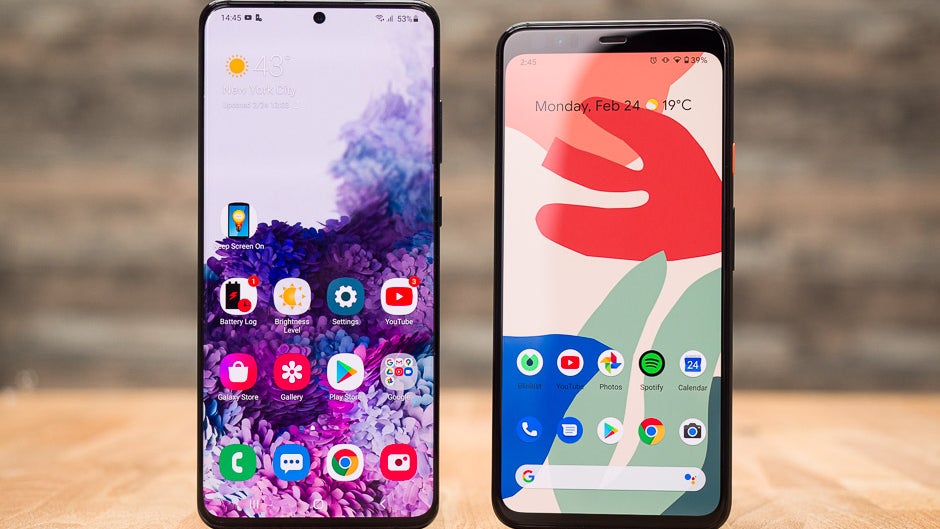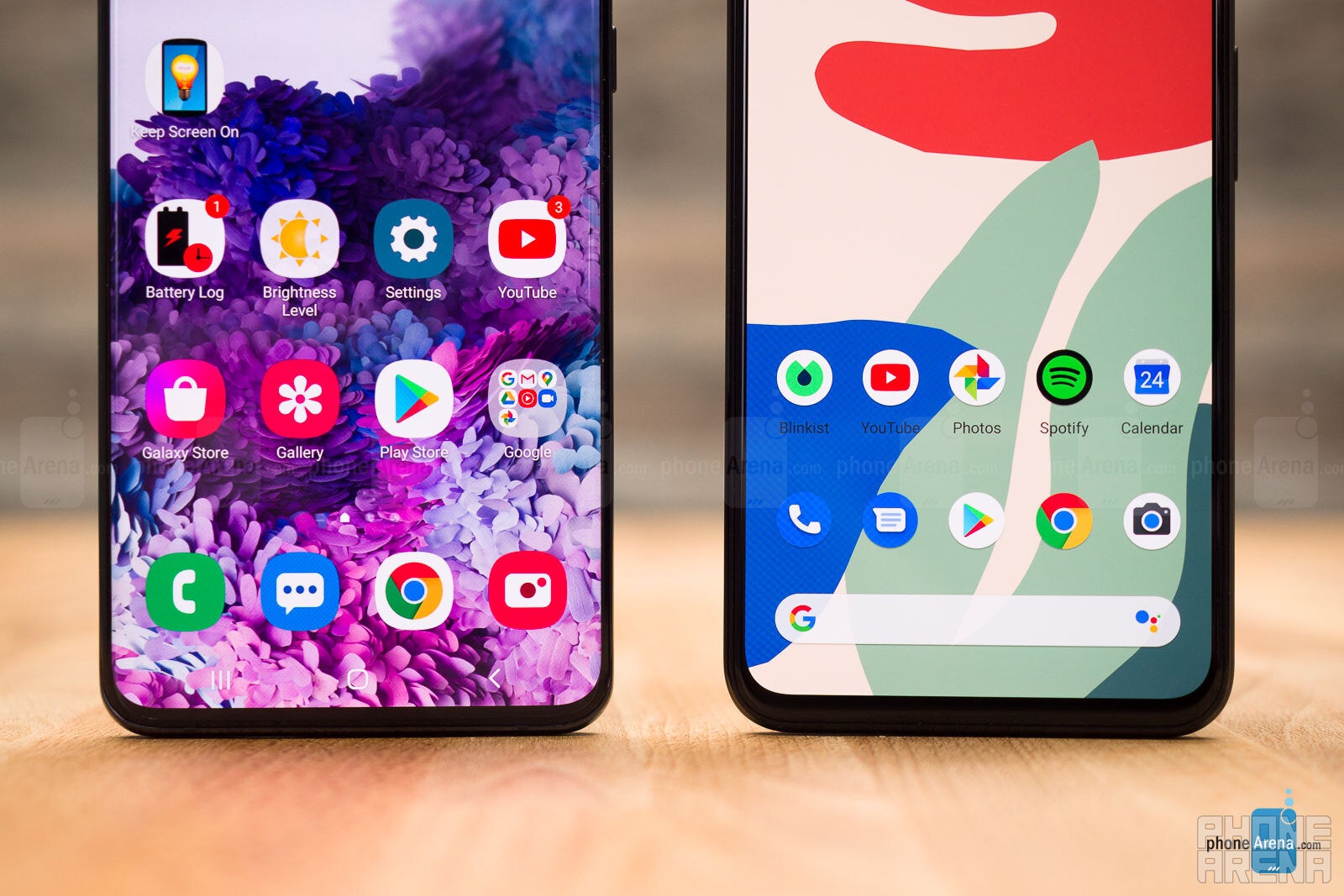Samsung Galaxy S20 Ultra vs Google Pixel 4 XL
We may earn a commission if you make a purchase from the links on this page.

Summary
Here we have two very different phones made for very different kinds of people.
The Samsung Galaxy S20 Ultra 5G is the company's most advanced phone right now, but at $1400, it's also one of its most expensive. It is a phone made for enthusiasts and professionals. Power users and content creators would truly appreciate the beautiful display, fast processor, versatile camera, large battery, and 5G connectivity. If its price is not an issue, this is the phone to get.
The Google Pixel 4 XL may not have the S20 Ultra's impressive specs sheet, but it is the phone we'd recommend to the average person. Its camera can't match the Galaxy S20 Ultra's zooming abilities and doesn't have a super wide-angle lens, but it's just as good for taking regular pictures, portraits, and selfies. While the phone comes with last year's hardware, it still feels plenty fast, and its Face Unlock is more reliable than Samsung's in-display fingerprint reader. The Pixel 4 XL's weakest spots are the low amount of on-board storage (64 or 128GB) and the average battery life. However, it's well worth checking out when it literally costs half as much as the S20 Ultra.
Buy Samsung Galaxy S20 Ultra 5G from:
Design and display
First, let's look at what these two phones have in common. Both the Galaxy S20 Ultra and the Pixel 4 XL are made of glass and metal. Both are resistant to dust and water ingress. Both come with stereo speakers and lack a headphone jack. I also want to point out that they're both rather conservative in terms of appearance: bland, flat rectangles you can get in a limited range of boring colors: black or grey for the S20 Ultra and black, white, or orange (limited edition) for the Pixel 4 XL.
A subtle difference I want to point out: the power button on the Galaxy S20 Ultra is positioned closer to the user's right thumb, while on the Pixel 4 XL it's a bit harder to reach.
As we've pointed out in the past, the screen on the Pixel 4 XL looks really, really good. But the one on the Galaxy S20 Ultra is even better – and not only for being larger. It also has great colors and a much higher brightness output.
The Pixel 4 XL display supports a 90Hz refresh rate which makes movement appear smoother. It's a subtle difference that makes the phone feels faster and more pleasant to use. The Galaxy S20 Ultra supports an even higher, 120Hz display refresh rate. It looks even smoother as a result, although few people may be able to tell the difference between 90 and 120Hz. Also, the 120Hz mode on the S20 Ultra only works at 1080p resolution setting.
Fingerprint reader vs Face recognition
Here's one thing the Pixel 4 does better than the Samsung Galaxy S20 Ultra. Google's phone uses face unlock to recognize its owner, and it works really well, even in challenging environments like in complete darkness. The Galaxy S20 Ultra, meanwhile, relies on an in-display fingerprint reader. It works fine, but it is less reliable than Google's solution. The S20 Ultra also supports facial recognition, but it's not quite as secure. It's an option added for convenience, mostly.
Camera and audio
The top reason for getting a Galaxy S20 Ultra is the powerful camera at the back: a 108MP main camera, a 48MP telephoto camera with 4x zoom, a 12MP super wide-angle camera, and an extra sensor for capturing depth information for portraits. The Google Pixel 4 XL seems vastly inferior with its 12MP main and 12MP 2x zoom telephoto camera, but as we've said in the past, specs alone never paint a full picture.
On the other hand, the Galaxy S20 Ultra takes better photos at night. With Night Mode enabled on both phones, image quality is comparable and very similar.
Zoom
The Galaxy S20 Ultra's strength lies in the powerful zoom capabilities of its camera. Technically, it goes up to 100x zoom, but pictures look quite terrible at that level of magnification. They look very impressive in the 10x - 30x range, however, and are better than the Pixel's zoomed-in shots. Curiously, the Pixel takes better pictures at 2x zoom with its telephoto cam. That's because the Ultra uses digital zoom only in the range between 1x and 3.9x. Its telephoto cam kicks in only once you get to 4x zoom. At night, on the other hand, the S20 Ultra is the better zoomer.
Wide-angle camera
Another advantage the Samsung Galaxy S20 Ultra has over the Pixel 4 XL is that it has a super wide-angle camera. This allows it to capture a wider scene without you having to step back. The Pixel 4 XL doesn't have such a lens, unfortunately. Here's the difference it makes:
Portrait mode and selfies
At a glance, selfies from both phones seem to be similar in quality, but when you take a closer look, you'll notice that the Pixel 4 XL captures more detail with its front camera. We believe there's a bug in the S20's camera system causing this, as that's how all our S20 models behave right now.
Portraits out of both phones look beautiful, with well-applied background blur and good object separation.
Video recording
As far as video recording goes, the Galaxy S20 Ultra has the upper hand. The Pixel's videos look pretty good, but the S20 Ultra supports higher recording quality with its 4K60 support and manual controls. 8K video capturing is also an option that pro videographers may be interested in.
Audio
Both phones have stereo speaker setups comprised of one loudspeaker on the bottom and the earpiece acting as a second speaker. The Galaxy S20 Ultra sounds pretty good, but the Google Pixel 4 XL beats it in this category with its loud, clear, bassy and balanced sound.
The Galaxy S20 Ultra, however, comes with a pair of good-sounding earbuds in the box, while the Pixel doesn't even have a USB-C to 3.5mm dongle. Neither phone has a headphone jack.
Software and performance

Once again, the Samsung Galaxy S20 Ultra is quite a few steps ahead of the Pixel. With 128 or 512GB of storage and up to 16GB of RAM, it is a future-proof powerhouse ready to deal with anything you throw at it. It is also powered by the new Qualcomm Snapdragon 865 chip and supports 5G connectivity.
The good news is that neither phone feels slow with day-to-day tasks. Even if you get the Pixel, you won't feel like you're getting a weaker phone – or at least you won't for another year.
Both phones run Android 10 out of the box, but as usual, Samsung has thrown a whole bunch of extra goodies in its best smartphone. You get Samsung's OneUI custom interface. In many ways, the experience is similar to using a Galaxy S10 – the software is laid out to be more comfortable for single-handed use. What's new here is Samsung's Quick Share, allowing you to send big files quickly to other Galaxy S20 phones. It's a lot like Samsung's version of AirDrop, really. You also get Live Captions, a feature that used to be found exclusively on Pixel phones. Think of it like automatic closed captions that work on any video.
The Pixel 4 XL runs a cleaner, lighter version of Android. It's not as feature-packed as Samsung's solution, but some might prefer it that way. Google brags with the hand gestures you can use to skip songs or silence alarms, and while they look cool, they're mostly just a gimmick. What could be useful to students – or anyone who often takes voice notes, really – is the Recorder app. It transcribes your words in real time as it hears and can create a text version of a voice recording. Neat!
Battery life
The Samsung Galaxy S20 Ultra has a 5000mAh battery, while the Google Pixel 4 XL relies on a 3700mAh cell. Hardly a surprise, the Ultra lasts longer on a single charge, especially if you choose to set the display to 60Hz instead of 120Hz. The Pixel will last you through a regular day, but its battery life can be only described as average.
Both phones support wireless charging. However, only the Galaxy S20 Ultra has reverse wireless charging, allowing it to act as a wireless power bank and charge accessories or other phones if needed.
Speaking of charging, the Galaxy S20 Ultra comes with a much more powerful charger in the box. Despite the larger battery that it packs, it is quicker than the Pixel in charging from zero to full.
Both phones support wireless charging. However, only the Galaxy S20 Ultra has reverse wireless charging, allowing it to act as a wireless power bank and charge accessories or other phones if needed.
Speaking of charging, the Galaxy S20 Ultra comes with a much more powerful charger in the box. Despite the larger battery that it packs, it is quicker than the Pixel in charging from zero to full.
Follow us on Google News


















Things that are NOT allowed:
To help keep our community safe and free from spam, we apply temporary limits to newly created accounts: